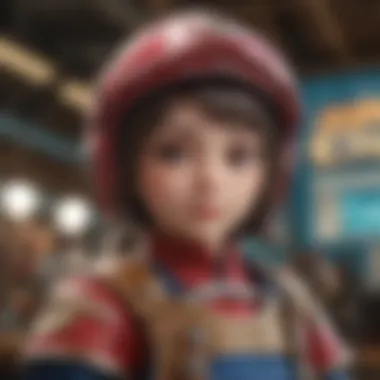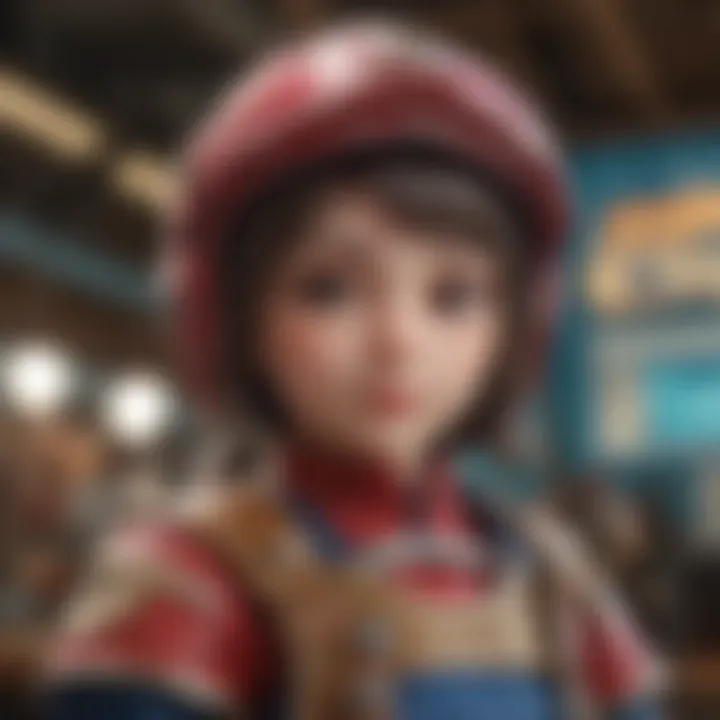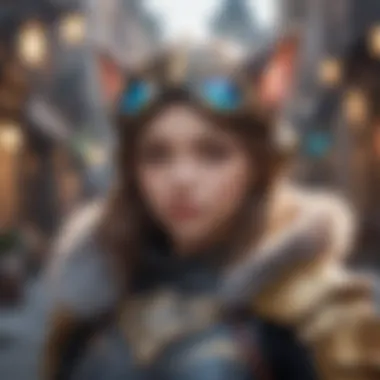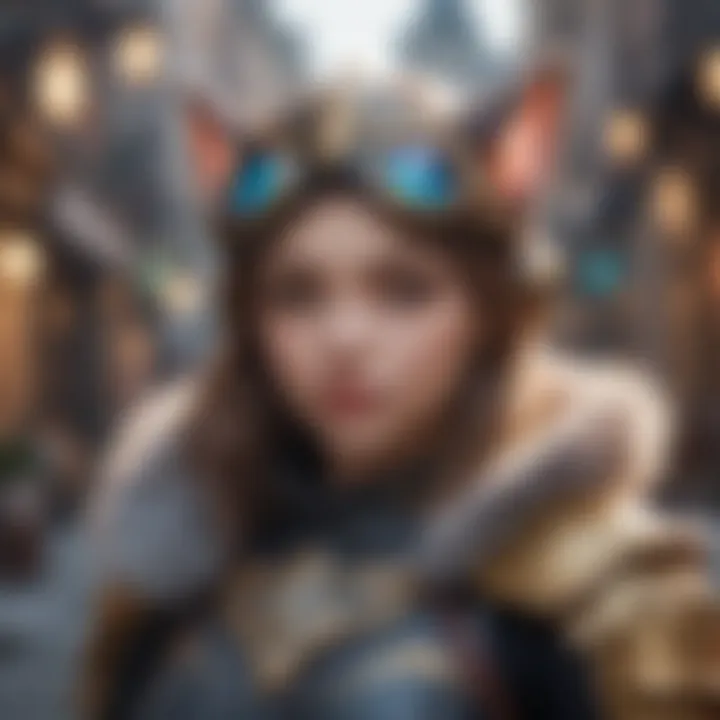Exploring Gacha Games: Insights from Summoners War


Intro
Gacha games have carved a significant niche in the mobile gaming ecosystem, captivating a wide audience with engaging mechanics and compelling narratives. One of the most notable titles in this genre is Summoners War, which showcases the typical elements found in gacha games while introducing unique features that set it apart. This article aims to explore the intricate landscape of gacha games, focusing primarily on Summoners War, while also considering similar titles. We will delve into various aspects, including gameplay mechanics, storyline depth, and community impact.
Overview of the Game
Game Title
Summoners War: Sky Arena
Release Date
The game was released on June 12, 2014.
Developer
Com2uS developed this mobile game, and it has continued to evolve since its initial release.
Genre
Summoners War primarily falls under the role-playing game (RPG) genre, specifically within the gacha category where players collect characters and engage in strategic battles.
Gameplay Review
Graphics Quality
The graphics in Summoners War are colorful and vibrant. It employs a distinctive art style that appeals to a broad audience. The visual effects during battles add to the excitement, keeping players engaged as they summon and control their monsters.
Controls
The touch controls are intuitive, allowing players to navigate menus and conduct battles with relative ease. Without complex button combinations or commands, players can focus on strategy rather than mechanics.
Mechanics
At its core, Summoners War features a gacha system where players summon monsters using in-game currency. These monsters can be upgraded, and strategic combinations can lead to powerful team compositions.
In-Game Features
Players can engage in various activities including:
- Arena Battles
- Dungeons
- Guild Wars
- World Boss Battles
These features promote player interaction and longevity of gameplay.
Storyline Analysis
Plot Summary
The storyline revolves around a mystical world filled with various monsters. Players take on the role of a summoner, tasked with capturing and training these creatures to battle against enemies and other players.
Characters
Summoners War offers a broad array of characters, each with unique abilities and attributes. These characters range from common to legendary, giving players a rich pool to draw from.
Pacing
The game's pacing is deliberate, as players gradually unlock new monsters and challenges. This steady progression allows players to fully experience the game’s mechanics without overwhelming them.
Narrative Depth
While the primary focus is on gameplay, the lore enriches the game world. Players find themselves immersed in a narrative that explains the origins of their monsters and the battles they engage in.
Community Impact
Popularity Trends
Summoners War has maintained a strong following over the years. With millions of downloads and a large active player base, it continues to be a significant title in mobile gaming.
Updates and Patches
Regular updates keep the game fresh, introducing new characters and features. These updates often respond to player feedback, showcasing Com2uS's commitment to its community.
Competitive Scene
There exists a competitive landscape around Summoners War. Players often participate in tournaments, showcasing their strategic prowess and offering a platform for top players to shine.
"The longevity of Summoners War is a testament to its captivating gameplay and the strong community it fosters."


This examination does not only reveal the intricate mechanics and the compelling nature of gacha games but also sheds light on the broader implications for the gaming industry. Understanding these elements can provide valuable insights for both players and developers.
Understanding Gacha Games
Gacha games represent a unique segment of the mobile gaming industry. They leverage specific game mechanics that captivate players while also driving substantial revenue. In this section, we will explore the intricacies of gacha mechanics and their place within a broader historical context. Understanding these elements is crucial for anyone interested in the dynamics of mobile games, especially regarding player engagement and economic models that underpin their success.
Definition of Gacha Mechanics
Gacha mechanics are primarily based on randomized rewards. This means players spend in-game currency or real money to obtain random virtual items, which can include characters or equipment. The term "gacha" originates from "gachapon," Japanese vending machines dispensing capsule toys. These mechanics tap into the psychology of collecting, encouraging players to try their luck for rare or powerful items.
In many gacha games, players accumulate in-game resources through gameplay or purchases. This resource is then used to enter draws or pulls, which yield an item of varying rarity. The excitement stems from not knowing what will be obtained, which is a fundamental element that keeps players invested.
Additionally, the tiered rarity often amplifies the allure. Items categorized as epic, legendary or ultra-rare tend to create anticipation and frenzy among players. This can lead to a cycle where players are motivated to spend more to improve their chances at acquiring desired items. Overall, gacha mechanics create a blend of hope and gratification, significantly contributing to player retention.
Historical Context
To understand gacha games fully, one must consider their historical background. The concept finds its roots in Japan, where gacha games began gaining traction in the early 2000s. Initially, they were simple browser-based games. Over time, with the rise of smartphones and mobile platforms, gacha games evolved significantly.
Titles such as Final Fantasy Brave Exvius and Granblue Fantasy showcased advanced graphics and deeper gameplay mechanics. They set precedents for other games, promoting a model that intricately coupled storytelling with gacha mechanics. Notably, this was not just a trend; it became a staple of mobile gaming.
The global expansion followed, as developers recognized the financial potential of this model. Now, gacha games are prevalent worldwide, and many contemporary titles draw inspiration from their predecessors. This historical perspective is vital to evaluate how gacha games have shaped player expectations and the landscape of mobile gaming today.
Understanding the mechanics and the historical journey of gacha games allows for a deeper appreciation of their impact. As we proceed through this article, these foundational insights will help clarify the appealing aspects of gacha titles, exemplified by Summoners War and others.
The Appeal of Summoners War
The fascination behind Summoners War goes beyond mere gameplay mechanics. This title stands out in the expansive realm of gacha games due to its unique blend of various compelling features that attract a diverse player base. The appeal lies in its strategic depth, engaging gameplay, and the excitement fostered by the character collection aspects. Understanding these elements provides insights into why Summoners War captures the attention of mobile gaming enthusiasts.
Gameplay Overview
Summoners War provides a rich gameplay experience that combines turn-based combat with real-time strategy. Players engage in battles using teams made up of summoned monsters, each possessing distinct abilities. The battles take place in multiple arenas, fostering both PvE and PvP experiences. This dual nature of gameplay caters to varied player preferences, enabling those who enjoy cooperative play to engage in dungeons while competitive participants can challenge others in the arena.
The game's nuanced mechanics encourage strategic thinking. Players must consider their team composition carefully, leveraging the strengths and weaknesses of different monsters. This complexity adds an essential layer, where information and skill contribute to success. With actions determined by carefully selected teams, the outcomes often depend on player planning prior to battle, enhancing the sense of accomplishment.
Moreover, regular updates and events keep the gameplay fresh. New monsters are periodically added and limited-time events provide opportunities for rare rewards. This constant evolution greatly enhances player engagement and retention, as there is always a new challenge or goal.
Character Collection and Development
Character collection is not simply a feature of Summoners War; it is the core of its appeal. The game allows players to collect a wide assortment of monsters, totaling over 1000 unique entities. Each monster comes with its own attributes and skills. This variety means players can pursue different strategies and build specialized teams based on their collected monsters.
Development is equally engaging. Players evolve and level up their monsters by using resources and in-game currency. This aspect gives players tangible goals and a sense of progression, important elements for long-term engagement. They can upgrade their monsters through the evolution process, which also enhances their capabilities and stats. This sense of ownership and progression is central to the player experience in Summoners War.
Furthermore, the game includes an intricate rune system that serves as a secondary layer of development. Runes dramatically change the abilities and effectiveness of monsters. The strategic selection and placement of runes introduce additional complexity, prompting players to think critically about how to build their teams.
In summary, the appeal of Summoners War lies in its intricate web of gameplay elements. The combination of engaging combat, extensive character collection, and continuous development opportunities captures and maintains player interest, forming a rewarding experience within the gacha game genre.
"Summoners War exemplifies the depth that gacha games can achieve, captivating a wide audience through its thoughtful design and strategic gameplay."
Regular updates and player involvement ensure continuous engagement, affirming that this title remains relevant in a competitive market.
Mechanics and Features of Gacha Games
Understanding the mechanics and features of gacha games is essential in demystifying what makes these titles so appealing to players. Gacha games employ various systems that not only drive player engagement but also foster a unique gaming experience. These mechanics help in keeping the community vibrant and make the gameplay dynamic. They affect the rate of player retention, engagement levels, and even spend behavior concerning in-game purchases. Let's explore some core elements that define gacha games.
Randomization in Character Acquisition
Randomization is a cornerstone of gacha mechanics. Players engage in acquiring characters or items through randomized draws. This uncertainty keeps the excitement alive, as players are often eager to see what they will obtain from their investments, whether it is time or money. The thrill derived from the chance of getting a rare character can foster a stronger emotional connection to the game.
Players may utilize different strategies when engaging with randomization. The ration of odds for getting a high-tier character may be minimal, making it even more enticing to try again. Summoners War, for example, has a summoning system where players can choose to use various resources like crystals or scrolls, each with differing success rates. A common discussion in community forums - such as those on reddit.com - revolves around the best approaches to maximize gains in random draws.
In-Game Currency Systems
In-game currency serves a pivotal role in gacha games, as it often feeds into the mechanics of character acquisition. Players typically earn currency through gameplay activities like completing missions, events, and challenges. A significant aspect of these systems is that they are often layered with the option of purchasing premium currency with real money. This model can lead to the question of balance and fairness in the game.
For instance, in Summoners War, there are different types of currencies: mana crystals, premium crystals, and others. Each currency can be utilized for specific draws and upgrades. The thought process on managing these currencies often leads to strategic considerations. Players need to weigh the benefits of saving currency for potential large draws against the risks of spending it immediately for smaller rewards. This tension shapes player behavior and engagement significantly.
Limited-Time Events and Promotions
Limited-time events and promotions add a layer of urgency and exclusivity to the player experience. These events often introduce unique characters, items, and special challenges that are only available for a short duration. Players are motivated to participate due to the fear of missing out, which can lead to increased spending and higher engagement rates.
Summoners War frequently hosts events that provide enhanced rewards for players who log in or complete special missions within a limited timeframe. This strategy fosters a sense of community as players often share tips on how to best approach the challenges posed during these events. The discussions in groups on facebook.com often circulate around maximizing the benefits derived from these promotions.
"The allure of gacha games lies not only in the thrill of randomization but also in the strategic considerations surrounding currency management and time-limited engagements."
By appreciating the nuances of these mechanics, one can better grasp why gacha games flourish in today's gaming landscape. Each feature contributes to a broader ecosystem that keeps players invested and returning for more.
Economic Models in Gacha Games


The economic models prevalent in gacha games play a significant role in their design, functionality, and popularity. Understanding these models helps to comprehend how these games monetize while providing players with engaging experiences. Gacha games often walk a tightrope between being accessible to a broad audience and the pressure to ensure continued revenue generation. Successfully navigating this balance can lead to a game’s long-term viability in a competitive market.
Economics is at the core of gacha game mechanics, particularly regarding player investment and game longevity. Players are attracted to the idea of acquiring rare and powerful characters or items, which keeps them engaged. However, the way this is structured can lead to different patterns of player spending, either through voluntary monetary contributions or in-game currency management.
Free-to-Play vs. Pay-to-Win
The dichotomy between free-to-play and pay-to-win models is a crucial point of discussion in gacha games. Free-to-play games allow players access without any initial investment, thereby widening the player base. This model often incorporates gacha mechanics, where players can use in-game currency, which can be earned through gameplay or purchased outright, to obtain characters or items.
In contrast, pay-to-win elements often emerge when purchasing in-game advantages significantly enhances gameplay. Games like Summoners War exemplify this; while players can compete without spending money, those willing to commit funds can progress faster and acquire superior characters. This leads to discussions about fairness and player satisfaction.
Many players enjoy the thrill of collecting, but excessive pay-to-win elements can lead to a fractured community. Some players feel discouraged if they encounter barriers that are easily overcome with money. Therefore, it's essential for developers to find a balance. Some strategies include offering valuable content without tying it exclusively to purchases.
"The balance between access and investment is delicate; getting it right is essential to retain players and maximize revenue."
Microtransactions and Spending Behavior
Microtransactions are a prevalent revenue model within gacha games, influencing how players engage with these titles. These transactions allow players to make small purchases, often for cosmetic items, boosters, or chances to earn rare characters.
Research indicates that spending behavior can differ widely among players. Some players may invest significantly in their experience, while others prefer to exploit the free aspects of the game. This variance necessitates a keen understanding of player demographics, motivations, and spending capabilities. Games often analyze player behavior to introduce tailored microtransaction offers to enhance revenue potential.
Microtransactions can be effective, yet they can also lead to player backlash if they are perceived as excessive or exploitative. Developers must implement systems transparently and ethically. Some gacha titles have introduced caps on spending or provided in-game rewards that can be earned through gameplay, alleviating concerns surrounding unfair advantages.
In summary, the economic models of gacha games, particularly the interplay between free-to-play and pay-to-win systems, along with the role of microtransactions, greatly influence player experience and behaviors. By approaching these models thoughtfully, developers can create sustainable ecosystems that reward player engagement and encourage a vibrant community.
Comparative Analysis of Similar Gacha Games
The landscape of gacha games is multifaceted, with each title bringing unique elements that resonate with players. Analyzing games similar to Summoners War helps understand the broader trends and mechanics at play. This comparative analysis allows for the exploration of distinct gameplay features, player progression systems, and community dynamics that create engagement.
Understanding these aspects can reveal why some games excel while others struggle to retain interest. Furthermore, it contributes to insights for developers seeking to innovate within the genre.
Genshin Impact: A New Challenger
Genshin Impact emerged as a groundbreaking title within the gacha genre, combining an expansive open world with a rich narrative and stunning visuals. Unlike traditional gacha games, Genshin Impact offers a seamless exploration experience where players can traverse vast landscapes in a 3D environment.
Key Features of Genshin Impact:
- Free Exploration: Players can roam freely, gathering resources and unlocking new areas without the constraints typical of many gacha games.
- Elemental Combat System: The game incorporates elemental interactions, allowing for layered combat strategies that enhance player choice.
- Character Swapping: Players can build teams with four characters, changing them in real-time during battles to leverage their unique abilities.
Genshin Impact's success can also be attributed to its frequent updates and engaging storylines, which keep the player base active. The gacha mechanics, while present, are integrated within this larger world, which allows for a more diverse gaming experience that attracts not just fans of gacha games but also regular RPG enthusiasts.
Fate/Grand Order: Influential Design Choices
Fate/Grand Order has set a standard for storytelling in mobile gacha games. With its strong narrative that combines historical and fictional characters, players are often drawn in by the compelling plots. The game employs a unique blend of turn-based combat and strategic team assembly.
Design Choices in Fate/Grand Order:
- Story Arcs: Each chapter presents rich, engaging storylines that captivate players, often leading to a deep emotional investment in the characters.
- Art and Character Design: The artwork is meticulously crafted, with each character featuring distinctive designs.
- Event-Driven Engagement: Fate/Grand Order frequently runs events that introduce new characters and limited-time story content, motivating players to log in regularly.
Through these design choices, Fate/Grand Order not only enhanced the traditional gacha experience but also focused on building a narrative that offers depth and emotional engagement, resonating strongly with its player base.
The comparative analysis of Genshin Impact and Fate/Grand Order sheds light on the diverse approaches within gacha games. While both titles utilize gacha mechanics, the way they integrate these elements into gameplay significantly impacts player experience and engagement.
Player Engagement Strategies
Player engagement strategies play a crtitical role in the overall success of gacha games like Summoners War. These strategies help maintain interest and loyalty among players, providing a dynamic gaming experience that encourages continued play. Through effective engagement tactics, developers can create a community atmosphere that makes players feel valued and connected to the game.
Community Building and Social Features
One of the main ways gacha games engage players is through community building. This is achieved by incorporating social features that foster interaction among users. In Summoners War, players can join guilds, participate in guild wars, and interact through chat systems. Such features create a sense of belonging, an aspect crucial in retaining players long-term.
Benefits of community-driven engagement include:
- Enhanced User Retention: When players feel connected, they are less likely to leave the game.
- Shared Goals: Collaborative features encourage players to work together, enhancing the overall experience.
- Increased Activity: Social elements often lead to more frequent logins and longer play sessions.
However, fostering a positive community requires careful management. Developers must ensure the environment remains friendly and free from toxic behavior, which can deter new players and alienate existing ones.
User-Generated Content and Customization
User-generated content (UGC) is another pivotal aspect of player engagement in gacha games. Allowing players to contribute has distinct advantages. For instance, Summoners War provides options for players to customize their characters and share their unique builds. This capability not only enriches the player experience but also empowers users by enabling creativity and personal expression.
The impact of user-generated content includes:
- Increased Player Investment: When gamers can modify their experience, they often feel more invested in the game.
- Diverse Gameplay: UGC leads to a variety of strategies and play styles, keeping the game fresh.
- Community Showcase: Players can showcase their creations, fostering pride and encouraging sharing within the community.
Nonetheless, developers must balance UGC by providing guidelines to ensure that the content is appropriate and aligned with the game's vision. By strategically utilizing community feedback and embracing the creative contributions of players, gacha games can elevate engagement to new heights.


Keeping players engaged is not only about mechanics but also about creating a shared environment where creativity and social interaction flourish.
The Role of Strategy in Gacha Gameplay
In gacha games, strategy shapes how players approach their experiences and influences their overall success. Strategically navigating through various challenges can greatly enhance the enjoyment derived from the game. The tactical decision-making involved impacts both individual accomplishments and progress within the game's community. Understanding the nuances of strategy in gacha games like Summoners War is essential for optimizing gameplay and achieving desired goals.
Team Composition and Synergy
Creating a well-balanced team is invaluable in gacha games. Success often relies on the combination of characters selected, as each character possesses unique skills, attributes, and elemental affinities. Developing a suitable team composition involves analyzing character strengths and weaknesses to maximize efficiency in battles and resource management. Players should consider several points:
- Diversity in Roles: It's important to include characters fulfilling different roles such as attackers, defenders, and support units. This enhances versatility in combat scenarios.
- Elemental Interaction: Characters may possess elemental attributes that interact in advantageous ways against opponents. Understanding these interactions can turn the tide of battle.
- Synergistic Abilities: Characters whose skills complement each other can create powerful combinations. Fostering these synergies can lead to consistent victories across various challenges.
The act of optimizing team composition is a continuous process, especially as players acquire new characters. Regular reassessment of the team allows adaptability to evolving game conditions and strategic challenges.
Long-Term Planning and Resource Management
Long-term thinking is crucial in gacha gameplay. Players need to account for resource management, as resources are often limited and must be allocated wisely. This involves careful planning to ensure characters are fully developed and are equipped to tackle future challenges. Here are some key considerations:
- Resource Allocation: Players should prioritize how to distribute resources across different characters that they want to strengthen. Focusing on a few key characters enables more effective growth.
- Event Participation: Engaging in limited-time events can yield valuable resources. Being proactive and planning participation can help players gain essential items while they are available.
- Character Progression: Understanding the progression mechanics of characters helps players avoid missteps such as over-investing in weaker characters. This insight prevents wasted resources and maximizes potential in-game.
"Long-term planning in gacha games not only impacts immediate gameplay success but can also influence a player's long-lasting enjoyment of the game."
Ultimately, the emphasis on strategy in gacha games cannot be overstated. Incorporating sound methods for team composition and long-term planning is pivotal for any player seeking to enhance their gaming experience.
Ethical Considerations in Gacha Games
The rise of gacha games has stirred significant discussions around the ethical dimensions these games operate within. As such, this section aims to dissect some of the most pressing ethical concerns associated with gacha mechanics. These considerations are critical for players, developers, and regulators alike, as they bear on the balance between business practices and user welfare.
Gambling-Like Elements
Gacha games often feature mechanics that mimic gambling. Players spend in-game currency or real money to obtain randomized rewards, which can lead to addictive behavior similar to traditional gambling. The thrill of a "pull" can induce excitement and anticipation, but it can also foster compulsive spending habits among users. This poses significant risks, particularly for younger audiences who might not fully grasp the financial implications of their actions.
Digital game mechanics such as loot boxes often come under scrutiny. Though companies justify this randomness as a form of entertainment, it can lead to regret and financial distress for players. Additionally, the presence of rare items or characters enhances this gambling aspect, encouraging users to invest more, often without a clear understanding of odds or payout structures.
It's important for players to recognize how the design of these games can exploit psychological factors for profit. Understanding this can help players make informed choices and engage critically with the games they play.
Regulatory Perspectives
As gacha games continue to gain popularity, regulatory bodies worldwide are beginning to examine their practices. Different countries have adopted varying approaches to address the challenges posed by gambling-like elements in gaming. In some regions, like the European Union, there are calls for stricter regulations that could redefine how these features are integrated into games.
Regulatory discussions frequently revolve around transparency, particularly regarding odds disclosure. Players often do not have adequate information about the likelihood of obtaining specific items, which raises ethical questions about informed consent.
Moreover, some jurisdictions are pushing for clear age restrictions and guidelines to protect vulnerable populations. In North America, certain states have proposed legislation that could classify loot boxes as a form of gambling, potentially leading to legal ramifications for game developers. This ongoing dialogue suggests a shift toward more scrutinized practices within the gaming industry.
The ethical concerns surrounding gacha mechanics necessitate a careful assessment regarding both player welfare and corporate responsibilities.
Players, as well as advocates for responsible gaming, are encouraged to engage with these discussions and communicate their thoughts on game design practices. Ultimately, the balance between player enjoyment and ethical responsibility will shape the future landscape of gacha games.
Future Trends in Gacha Gaming
The landscape of gacha gaming continues to evolve. As technology and player preferences change, developers must adapt or risk losing their audience. This section explores important trends that are shaping the future of gacha games. These trends highlight key elements, benefits, and considerations for both players and developers.
Innovations in Gameplay
The future of gacha innovation lies in gameplay mechanisms that enhance immersion. One notable aspect is the integration of real-time player interactions. This means that players may experience more dynamic gameplay environments where choices can impact the world in real-time. For example, games could feature events where player decisions collectively influence an entire campaign outcome.
Another innovation is cross-platform play. Many players desire flexibility in how they engage with their favorite games. Facilitating access via mobile, PC, or console allows a larger audience and enhances user retention. Moreover, augmented reality (AR) offers a new frontier. By overlaying digital elements onto the real world, players can experience a deeper connection to the characters they collect and the battles they fight.
Furthermore, adaptive AI is becoming more prevalent. Applying AI that adjusts difficulty based on a player's skill level can provide a tailored experience, making gameplay challenging yet rewarding. As a result, this can lead to increased player satisfaction and engagement over time.
Impact of Technology on Game Design
Advancements in technology directly impact how gacha games are designed. A significant change is in the use of cloud gaming. Platforms like Google Stadia and Nvidia GeForce Now allow players to enjoy high-quality gaming without the need for powerful hardware. This can potentially alter the pricing and monetization strategies developers use.
Blockchain technology is another game-changer. Its introduction can offer players ownership over digital assets, resulting in a real marketplace for in-game items. This could lead to new economic models where players can buy, sell, or trade their characters and resources in a way that was previously impossible.
Moreover, the increasing ability to implement machine learning algorithms allows developers to better understand player behavior. By analyzing gameplay data, developers can refine mechanics, optimize user experience, and anticipate market trends. Furthermore, improved analytics may enhance in-game events and marketing strategies, driving engagement through tailored content.
"Gacha games are not just about chance anymore; they are about creating experiences shaped by technology and player choices."
In summary, the future trends in gacha gaming point toward an integrated experience that values player input and leverages technology to innovate gameplay. This ongoing evolution will determine the next wave of popular titles in the industry.
The End
In summary, this exploration of gacha games, particularly through the lens of Summoners War and similar titles, shines a light on what makes this genre captivating for mobile gaming enthusiasts. The various mechanics and features discussed illustrate how player engagement is crafted through elements such as randomization, character collection, and strategic gameplay. As players interact with these gaming ecosystems, the social features and community aspects further foster a sense of belonging and participation.
One cannot overlook the economic models that drive these games. The balance between free-to-play and pay-to-win strategies is critical, posing significant implications for player experience. Understanding these dynamics allows players to navigate their choices more wisely and enhances their overall enjoyment of the game. Moreover, the ethical considerations surrounding gambling-like mechanics highlight the need for ongoing discourse among developers and regulators.
"The gacha game model reflects contemporary digital engagement patterns, revealing both opportunities and challenges for players and developers alike."
Looking ahead, the future trends in gacha gaming suggest a fertile ground for innovation. As technology advances, games are likely to evolve, offering richer narratives and more immersive experiences. Players’ preferences will continue to shape game design, allowing for a constant adaptation to meet their desires. This conclusion not only encapsulates the key findings but also emphasizes the importance of continuous exploration in this ever-evolving landscape of mobile gaming.
Ultimately, gacha games represent a multifaceted segment of gaming culture, merging chance, strategy, and community, thus influencing the broader mobile gaming industry. For enthusiasts, understanding these layers enhances their engagement and appreciation, ensuring that this genre remains relevant in the years to come.



